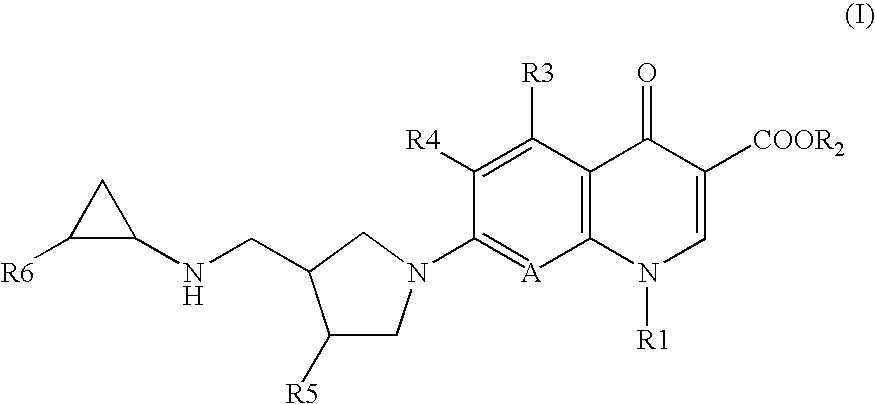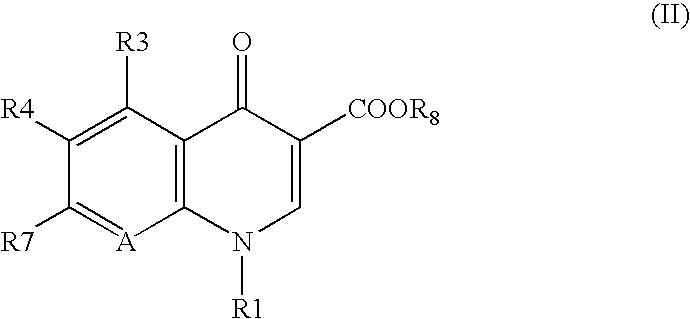7-(4-Substituted-3-cyclopropylaminomethyl-1 pyrrolidinyl) quinolonecarboxylic acid derivative
a technology of pyrrolidinyl and quinolonecarboxylic acid, which is applied in the field of new drugs, can solve the problems that antibacterial agents cannot be effective countermeasures to gram-positive drug-resistant bacteria, and pose a serious threat to the treatment of infectious diseases, and achieves strong antibacterial activity and safe use.
- Summary
- Abstract
- Description
- Claims
- Application Information
AI Technical Summary
Benefits of technology
Problems solved by technology
Method used
Image
Examples
reference example 1
Synthesis of trans-3-cyclopropylaminomethyl-4-methylpyrrolidine
Step 1:
[0069] trans-1-Benzyl-4-methyl-3-pyrrolidine carboxylic acid (4.04 g) was dissolved in dichloromethane (50 mL). To this solution, 1,1′-carbonyl bis-1H-imidazole (3.58 g) was added and the mixture was stirred at room temperature for 1 hour. While the mixture was chilled in an ice bath, cyclopropylamine (1.53 mL) in dichloromethane (15 mL) was added dropwise and the mixture was stirred at room temperature for 3 hours. Subsequently, the reaction mixture was washed with water, dried over anhydrous sodium sulfate, and concentrated under reduced pressure. The residue was crystallized from a hexane / diisopropyl ether mixture, and the crystals were filtered, washed with a hexane / diisopropyl ether mixture, and dried under reduced pressure to give trans-1-benzyl-N-cyclopropyl-4-methyl-3-pyrrolidine carboxamide as white crystals (4.07 g).
[0070] MP: 81-83° C.
[0071] MS (EI) m / z: 258(M+).
Step 2:
[0072] trans-1-Benzyl-N-cy...
reference example 2
Synthesis of (3R,4R)-3-cyclopropylaminomethyl-4-methylpyrrolidine
Step 1:
[0087] (3R,4R)-1-Benzyl-4-methyl-3-pyrrolidine carboxylic acid (6.27 g) was suspended in dichloromethane (250 mL). To this suspension, cyclopropylamine (1.76 mL) and 1-ethyl-(3-dimethylaminopropyl)carbodiimide hydrochloride (12.2 g) were sequentially added and the mixture was stirred at room temperature for 4 hours. Subsequently, the reaction mixture was washed with water, dried over anhydrous sodium sulfate, and concentrated under reduced pressure. The residue was purified by silica gel column chromatography (ethyl acetate: methanol=10:1) to give (3R,4R)-1-benzyl-N-cyclopropyl-4-methyl-3-pyrrolidine carboxamide (3.32 g) as white crystals.
[0088] MS (EI) m / z: 258 (M+)
[0089] Elemental analysis (%)
[0090] Calcd for C16H22N2O: C, 74.38; H, 8.58, N, 10.84.
[0091] Found: C, 74.46; H, 8.67, N, 10.72.
Step 2:
[0092] Using (3R,4R)-1-benzyl-N-cyclopropyl-4-methyl-3-pyrrolidine carboxamide (5.52 g), the same procedur...
reference example 3
Synthesis of (3S,4S)-3-cyclopropylaminomethyl-4-methylpyrrolidine
Step 1:
[0107] Using (3S,4S)-1-benzyl-4-methyl-3-pyrrolidine carboxylic acid (14.5 g), the same procedure was followed as in Step 1 of Reference Example 2 to give (3S,4S)-1-benzyl-N-cyclopropyl-4-methyl-3-pyrrolidine carboxamide as pale brown crystals (6.33 g).
[0108] MS (EI) m / z: 258 (M+).
[0109] Elemental analysis (%)
[0110] Calcd for C16H22N2O: C, 74.38; H, 8.58, N, 10.84.
[0111] Found: C, 74.64; H, 8.66, N, 10.71.
Step 2:
[0112] Using (3S,4S)-1-benzyl-N-cyclopropyl-4-methyl-3-pyrrolidine carboxamide (6.13 g), the same procedure was followed as in Step 2 of Reference Example 1 to give (3S,4S)-1-benzyl-3-[[(N-tert-butoxycarbonyl-N-cyclopropyl)amino]methyl]-4-methylpyrrolidine (4.67 g) as a pale brown oil.
[0113] MS (FAB+) m / z: 345 (MH+).
[0114] HRMS (FAB+)
[0115] Calcd for C21H33N2O2(MH+): 345.2542.
[0116] Found: 345.2547.
Step 3:
[0117] Using (3S,4S)-1-benzyl-3-[[(N-tert-butoxycarbonyl-N-cyclopropyl)amino]methyl...
PUM
| Property | Measurement | Unit |
|---|---|---|
| Antimicrobial properties | aaaaa | aaaaa |
Abstract
Description
Claims
Application Information
 Login to View More
Login to View More - R&D
- Intellectual Property
- Life Sciences
- Materials
- Tech Scout
- Unparalleled Data Quality
- Higher Quality Content
- 60% Fewer Hallucinations
Browse by: Latest US Patents, China's latest patents, Technical Efficacy Thesaurus, Application Domain, Technology Topic, Popular Technical Reports.
© 2025 PatSnap. All rights reserved.Legal|Privacy policy|Modern Slavery Act Transparency Statement|Sitemap|About US| Contact US: help@patsnap.com



